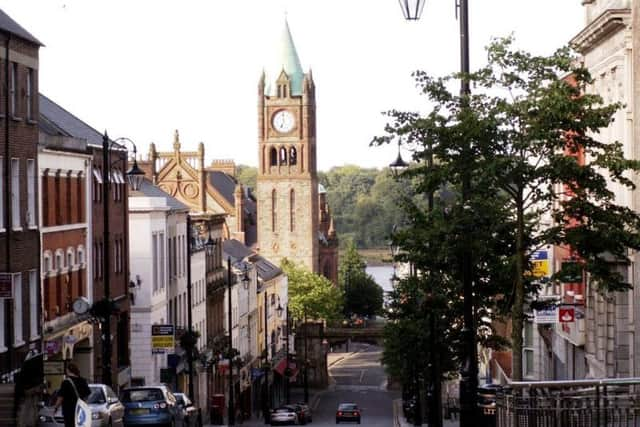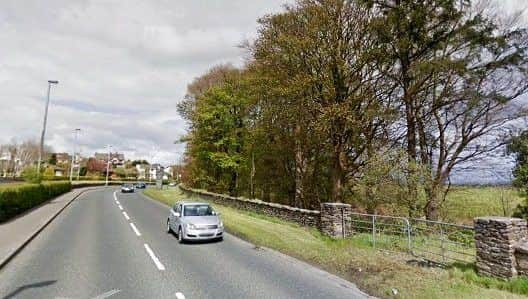21st century Derry has to make room for safe cycling


The bicycle celebrated its two hundredth birthday earlier this year, and is benefiting from a new wave of global popularity.
Older readers may recall the years up to the late 1960s when cycling still played an important role in helping many people to get around. That slowly ended as the car came to be seen as the “modern” way to travel and urban areas were altered to let vehicles dominate them.
Advertisement
Hide AdAdvertisement
Hide AdAll other transport modes were pushed to the margins, and cycling was reduced to primarily a leisure pursuit - as people feared sharing busy road space with speeding one-tonne chunks of metal.


In recent years, cycling has made a comeback as a transport option. Whilst no-one expects bikes to replace cars entirely, there is a wealth of evidence from around the world that, if you build safe segregated cycle lanes, people will cycle more and use their cars less - particularly for shorter journeys of a couple of miles.
Some cities have experienced rapid change after installing safe cycle lanes. In the morning rush hour in central London, a third of all vehicles on the roads are now bicycles and transport officials predict that more people will be commuting into central London by bike than by car within a few years.
Closer to home, Dublin and Belfast are investing in their infrastructure to make cycling a genuine transport choice for people again. And, in Cork, politicians from different parties combined last week to call for greater investment in cycling there.
Advertisement
Hide AdAdvertisement
Hide AdAs is often the case, Derry is, unfortunately, lagging behind other cities when it comes to this cycling renaissance. The good news is that we have a growing network of greenway cycle routes in parts of the city which are great for leisure cyclists. The problem, however, is that they tend to be located away from where people live, work, study etc, which reduces their appeal for everyday usage.


The 2011 Census revealed that Derry has the second lowest percentage of people travelling to work by bicycle every day in Northern Ireland, at only 0.5% - a poor statistic for the second biggest city. Derry does not currently have a culture of cycling and it is increasingly marking us out as unusual amongst cities.
A myth you often hear when cycling in Derry is mentioned is that the city is just too hilly. Whilst Derry does, indeed, contain hills, a huge chunk of the Cityside was built in a valley and most of the major road arteries there are flat. You can travel from Derry’s most westerly point at Bridgend, along the entire length of Buncrana Rd, onto Strand Rd for its entire length, through the city centre towards Craigavon Bridge and, then, out the Foyle Rd to the southern edge of the city - and all on roads that are as flat as a pancake. Think of all the facilities and the tens of thousands of people who live on or close to that flat route and tell me that Derry is too hilly to cycle. For some people, it undoubtedly is - though, thankfully, electric bicycles can help to address that. But, for the thousands of people who live near the city’s many flat parts, Derry’s topography is not a genuine barrier to cycling.
There are four main reasons why we should be encouraging more people to cycle here.
Advertisement
Hide AdAdvertisement
Hide AdFirst - one of the key challenges all cities face (including our own) is congestion. Cities that tackle that problem well will become better places to live. Those that don’t will condemn their citizens to a lower quality of life, lost productivity, higher air pollution and poorer individual health. In short – anywhere that doesn’t deal with traffic is set to fail. Cycling isn’t the answer to congestion on its own, but it is certainly part of the solution.


Second are the environmental benefits. Cars not only contribute to global warming and the problems that causes (e.g. the freak flooding here last month), they also cause air pollution in cities.
Thirdly, Derry & Strabane has some of the worst health statistics in Northern Ireland. Recent research has shown that cycling is the only mode of transport which, if incorporated into your everyday life, will give you significant health benefits. Cycling daily is the equivalent of a magic pill which will reduce your risk of death by almost half. By encouraging and enabling people to make active travel part of their everyday lives, we will help to reverse the appalling health statistics that blight our area.
Finally, there is also a social justice angle. Whilst one in five households in Northern Ireland don’t have access to a car or a van, the figure for Derry & Strabane is much higher - at over one in three (36%). Yet the travel needs of car owners receive almost all the transport focus and investment locally, whilst the needs of the remaining third of our population are broadly ignored. With proper investment, cycling can become a viable travel option for those who don’t have access to a vehicle.
Advertisement
Hide AdAdvertisement
Hide AdFour key ingredients are required to create a genuine cycling city: safety, convenience, access and social acceptability. Safety is the main priority. Riding a bicycle should be a normal way to get around our city for anyone aged eight to 80 years old and should require neither bravery nor armour to do so.


Convenience is about ensuring that residential and commercial areas have places to safely lock or store bicycles and that neighbourhood centres are designed to be accessible on foot and by bicycle and not just by car.
Improving access to cycling would include initiatives like the bike share schemes that are increasingly common elsewhere (including Belfast and Dublin), whilst social acceptability is about ensuring cycling is viewed as a viable and positive way to travel - particularly to work or school.
In summary, having a culture of cycling means increasing people’s choice through giving them another viable method to travel safely in their everyday lives.
Advertisement
Hide AdAdvertisement
Hide AdCities get the kind of traffic they build for and we are at a crucial point in deciding what future awaits Derry. A new ‘Cycle Derry’ campaign group has been established to secure safe space for cycling locally and they are particularly keen to see segregated cycle lanes included when the Buncrana Rd is dualled. If that happens, we will have taken a big step towards Derry joining the list of modern, progressive cities that are taking cycling seriously.
If it doesn’t, it will signal that Derry’s transport planning is stuck in the last century and our city will be condemned to decades more pollution and congestion. The choice is simple. If we want to make Derry fit for the 21 st century, we have to make room for safe cycling.
* Cycle Derry is to hold its first meeting on September 20 (7pm) at the Inner City Trust building, 31-33 Shipquay St. All welcome.
Steve Bradley is a native of Derry who works as a regeneration consultant in England. He can be followed on Twitter at @bradley_steve